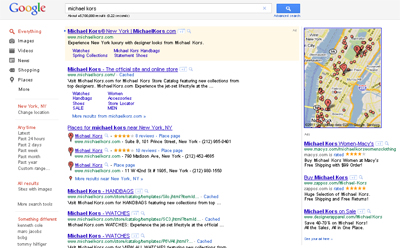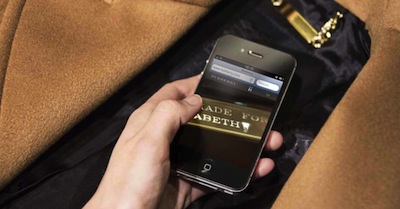 Michael Kors uses Snapchat
Michael Kors uses Snapchat
In a quest to facilitate the consumer’s path to purchase, luxury fashion brands are looking to improve search and display advertising, according to a new report by L2. The majority of desktop traffic is driven by online searches, and it is especially important for brands to make it as easy as possible for consumers to find and purchase their products online. With mobile poised to overtake desktop as the most popular platform, brands are also increasingly focusing their advertising efforts there.
"Fashion brands are understandably hesitant to risk brand equity with placements on sites that are commonly found in programmatic channels," said Eleanor Powers, director, Insight Reports, at L2, New York. "Luxury brands, however, can maintain brand safety through using programmatic direct.
"As programmatic direct capabilities become more available through quality publishers, Fashion brands will likely follow."
L2's Fashion: Search and Display Advertising examined data from 90 leading fashion brands. Search and rescue Search engine optimization is one of the best ways for brands to improve visibility and facilitate the path to purchase. It is important for brands to secure first-page real estate on Google so consumers can find their products. Google search is an important part of marketing strategy
Almost all of the fashion brands surveyed by L2 succeeded in holding the first place result for associated brand terms or “organic branded search.” They were not, however, able to dominate the entire first page.
Retailers and etailers took the majority of the first-page spots, with Nordstrom and Neiman Marcus leading the group. Nordstrom captured 39 percent of the first page while Neiman Marcus took 24 percent.
Etailers Net-A-Porter and Amazon were also successful with Net-A-Porter taking 26 percent and Amazon and its affiliates controlling 39 percent. Consumers are increasingly looking to research products online before purchasing, and these sites provide extensive product details.
Google search is an important part of marketing strategy
Almost all of the fashion brands surveyed by L2 succeeded in holding the first place result for associated brand terms or “organic branded search.” They were not, however, able to dominate the entire first page.
Retailers and etailers took the majority of the first-page spots, with Nordstrom and Neiman Marcus leading the group. Nordstrom captured 39 percent of the first page while Neiman Marcus took 24 percent.
Etailers Net-A-Porter and Amazon were also successful with Net-A-Porter taking 26 percent and Amazon and its affiliates controlling 39 percent. Consumers are increasingly looking to research products online before purchasing, and these sites provide extensive product details.
 Many brands choose to advertise on popular publications like Vogue
Unfortunately, when it comes to non-branded search times like “evening gown” or “handbag” fashion brands were unsuccessful in capturing top spots. Consumers vastly prefer multi-brand sites such as Nordstrom.
Some brands were more successful than others in landing on the first page. Ralph Lauren was the most visible, appearing on the first-page 2 percent of the time for women’s apparel and 21 percent of the time for men’s.
The future of search optimization will likely lie in mobile where many brands are focusing their current efforts. Changes in Google’s algorithm have made this increasingly important, and most brands have changed strategies accordingly.
Many brands choose to advertise on popular publications like Vogue
Unfortunately, when it comes to non-branded search times like “evening gown” or “handbag” fashion brands were unsuccessful in capturing top spots. Consumers vastly prefer multi-brand sites such as Nordstrom.
Some brands were more successful than others in landing on the first page. Ralph Lauren was the most visible, appearing on the first-page 2 percent of the time for women’s apparel and 21 percent of the time for men’s.
The future of search optimization will likely lie in mobile where many brands are focusing their current efforts. Changes in Google’s algorithm have made this increasingly important, and most brands have changed strategies accordingly.
 Brands are increasingly spending on mobile advertising
Move to mobile
This year marks a significant turning point for mobile advertising as spending on mobile is expected to overtake desktop for the first time.
Mobile’s share of digital ad spending has been growing more quickly than expected and, as a result, the spend on desktop ads will peak this year as marketers turn their focus to reaching smartphone and tablet users, according to data from eMarketer.
In 2013, the bulk of incremental growth in overall digital advertising came from mobile, which accounted for $7.7 billion of the $41.9 billion spent on digital ads that year. The trend has accelerated going forward, with desktop banner and search advertising seeing flat or declining growth in 2014 for the first time ever (see story).
New strategies are required for brands looking to capture consumers’ attention on mobile. As consumers increasingly use their smartphones and tablets as a primary device for searching, a combination of social media and location can be used to influence keywords and ultimately make for a more tailored and personalized mobile search experience.
Consumers who search on their mobile devices are looking for specific information, which is usually time or location-sensitive. With the high amount of social media activity happening on mobile devices, weaving social recommendations into search results will help marketers make the most of their search campaigns (see story).
There are a number of considerations brands must take in mind when focusing their attention on mobile advertising.
Brands are increasingly spending on mobile advertising
Move to mobile
This year marks a significant turning point for mobile advertising as spending on mobile is expected to overtake desktop for the first time.
Mobile’s share of digital ad spending has been growing more quickly than expected and, as a result, the spend on desktop ads will peak this year as marketers turn their focus to reaching smartphone and tablet users, according to data from eMarketer.
In 2013, the bulk of incremental growth in overall digital advertising came from mobile, which accounted for $7.7 billion of the $41.9 billion spent on digital ads that year. The trend has accelerated going forward, with desktop banner and search advertising seeing flat or declining growth in 2014 for the first time ever (see story).
New strategies are required for brands looking to capture consumers’ attention on mobile. As consumers increasingly use their smartphones and tablets as a primary device for searching, a combination of social media and location can be used to influence keywords and ultimately make for a more tailored and personalized mobile search experience.
Consumers who search on their mobile devices are looking for specific information, which is usually time or location-sensitive. With the high amount of social media activity happening on mobile devices, weaving social recommendations into search results will help marketers make the most of their search campaigns (see story).
There are a number of considerations brands must take in mind when focusing their attention on mobile advertising.
"The consumer shift to mobile platforms only makes the digital advertising landscape more challenging for Fashion brands," Ms. Powers said. "This is especially true for smartphones where the small screen increases the competition for search real-estate and makes top placement more of a necessity.
"Display advertising for branding campaigns on a small screen is also much more challenging. Last but not least are issues related to targeting measuring advertisement cross-platform."
Final Take Kay Sorin, editorial assistant on Luxury Daily, New York